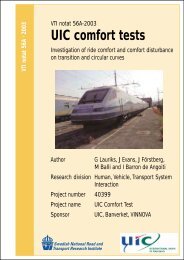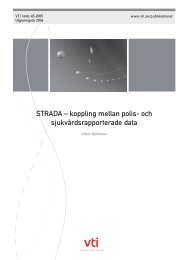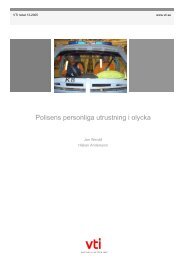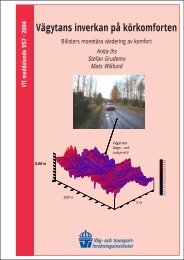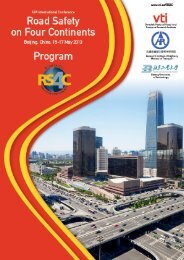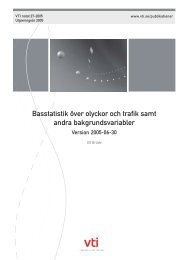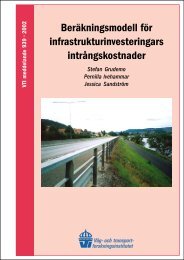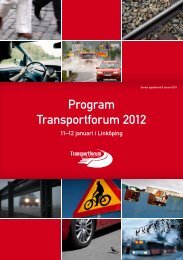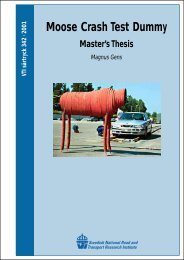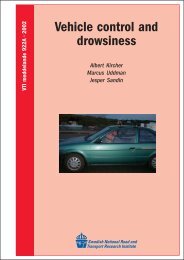Create successful ePaper yourself
Turn your PDF publications into a flip-book with our unique Google optimized e-Paper software.
Long-term performance study of different pavement structures. A ten year study<br />
of flexible, semi-rigid and rigid pavement structures, 1996–2006<br />
by Leif G Wiman, Håkan Carlsson, Leif Viman and Bengt-Åke Hultqvist<br />
<strong>VTI</strong> (Swedish National Road and Transport Research Institute)<br />
SE-581 95 Linköping Sweden<br />
Summary<br />
In connection with the construction of a new part of the European road 6 (E6) close to<br />
the city of Halmstad, (section Fastarp–Heberg), the Swedish Road Administration<br />
decided to investigate the long-term behaviour of different types of pavement structures.<br />
<strong>VTI</strong> got the mission to make documentation during the construction and to follow-up<br />
the performance of these pavement structures on selected sections. The total length of<br />
this new road was 21 km and 1/3 was constructed with flexible pavement structures and<br />
2/3 with rigid pavement structures (cement concrete). The road section was opened to<br />
traffic in the autumn 1996.<br />
The main objective of the study is to investigate the pavements resistance to rutting,<br />
both regarding wear from studded tires and deformation from heavy traffic. The<br />
objective is also to study surface characteristics, such as evenness, friction and noise.<br />
This report includes results and analyses from the first ten years of the study (1996–<br />
2006).<br />
In summary the conclusions so far are as follows:<br />
• Performance based specifications clearly improved the deformation<br />
properties of the bitumen bound layers.<br />
• Semi-rigid pavement structures showed good resistance to rutting.<br />
• Investigation is needed to improve the resistance to reflective cracking of the<br />
semi-rigid structures.<br />
• The vertical position of the steel net in reinforced flexible structures is<br />
important. A position below a thin wearing course (40 mm) can not be<br />
recommended according to this study.<br />
• More than half of the surface rutting on the flexible structures could be<br />
referred to deformation from the heavy traffic and a great deal of the<br />
deformation occurred after the first year.<br />
• Rigid pavement sections showed good wear resistance.<br />
• The difference in surface friction and noise was small between flexible and<br />
rigid pavement sections, however, regarding noise, it was only followed-up<br />
during the first three years of the study.<br />
<strong>VTI</strong> rapport 632 11



